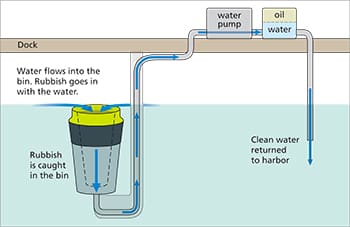When it comes to ocean pollution, the Great Pacific garbage patch might be considered the poster child. Voyagers and ocean racers have testified to its size. An article in the British paper The Independent cited American oceanographer Charles Moore, who estimated that “…about 100 million tons of flotsam are circulating in the region.” And not all of that are large pieces at the surface. As some plastic breaks down, it turns into progressively smaller bits, some of which float inches or feet below the surface, constituting what scientists call “a translucent soup of degrading plastic.”
Two Australian sailors, Pete Ceglinski and Andrew Turton, now based in Majorca, thought about the problem of plastic and petroleum pollution at the local level. They noticed how trash would accumulate in harbors, “from being constantly exposed to rubbish floating in the water all around the world in marinas,” wrote Ceglinski in an email.
They came up with a way to capture it, similar a pool skimmer. A skimmer inlet is just below water level and debris gets entrained in the water falling into it. The Seabin guys use the same approach. The cylindrical skimmer sits a few inches below the surface and is connected to a pump up that draws water into the collector unit. The collector traps debris in a screen that can be removed for cleaning. The cleaned water is dumped back into the harbor. The Seabin also has the option for an oil separator for removing oily residue. The French Mediterranean port of La Grande Motte has signed an R&D agreement with Seabin for a program to reduce floating waste. Ceglinski and Turton have run a successful crowdfunding effort to bring Seabin to market. “We expect to ship Seabin units by the end of the year,” wrote Ceglinski.
Learn more at www.seabinproject.com.

